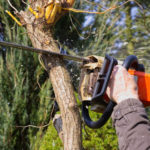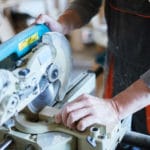If you are a workshop owner or a woodworker, you’ve probably heard of the terms “rip-cut” and “cross-cut”. These two cuts are used in many different ways to create various types of woodworking projects. The cuts are attained by using specific tools, namely, rip saw and crosscut saw.
In this article, we’ll discuss what they are and how they’re used. We will also show some examples of each type of cut.
What Is A Rip Cut?
A rip cut is an operation where a piece of material is sliced into thin strips. It involves cutting a piece of wood parallel to the grain. The advantage of ripping is that it creates uniform thicknesses of stock. This makes the finished product look more professional.
The process of ripping can be done manually by hand with a circular saw or by using power equipment as a rip saw. However, manual ripsawing requires skill and experience to get perfect results.
Also, if you choose to use a manual saw, you need to make sure that your blade is sharp enough to cut through the wood without damaging the surface. If you don’t have any experience with a rip saw, then it’s best to hire someone who has been doing it for years.
The other option is to buy a rip saw which is designed specifically for this purpose. There are several models available in the market today. You can find them at most hardware stores.
What Is A Rip Saw?
A rip saw is basically a tool that allows one to slice off small pieces from a board. They come in handy when making smaller parts out of larger boards. Ripping helps in creating straight lines and even surfaces.
A rip saw’s teeth work like little chisels and help remove the material from the board. The teeth are set in such a way that they follow the direction of the grain. This means that the teeth move along the same path as the grain. In simple terms, the rip narrows down the width of the board.
There are two main types of rip saws:
- Hand-held rip saws
- Benchtop rip saws
Hand-held rip saws are usually portable and lightweight. They allow users to easily move around while working. On the other hand, benchtop rip saws are heavier than their handheld counterparts. They are often used in large-scale operations because of their strength and durability.
What is a Rip Saw Used For?
A rip saw can be used to make all kinds of things including furniture, cabinets, door panels, etc. Some people prefer to use them over a jigsaw. Both methods produce similar results but the rip saw produces better quality products.
When you want to make something that needs to be sturdy and long-lasting, a rip saw is the right choice. Its durability and precision allow you to create precise edges.
You may also want to consider buying a rip saw if you plan to do a lot of DIY projects. With a rip saw, you won’t need to spend hours sanding down rough edges. You can simply take off the excess material with ease.
Another reason why you should invest in a rip saw is that it saves time. When you use a rip saw, you only need to cut the material once instead of having to cut it multiple times.
What is a Cross Cut?
A cross-cut is a type of sawing technique that cuts material perpendicular to its length. Unlike a rip saw, a cross-cut doesn’t change the width of the material. Instead, it changes the angle of the material.
Crosscuts are commonly used for cutting plywood into different sizes. It is also useful for cutting up scrap materials into usable pieces.
Crosscuts require a special kind of saw called a crosscut saw. These saws are specially designed to perform crosscuts.
What is a Crosscut Saw?
A crosscut saw is a special type of saw that is designed to perform crosscuts on wood. Most crosscut saws are made of steel. They are heavy-duty tools that are meant to last longer.
Crosscut saws are generally more expensive than regular rip saws. However, they are worth every penny. They are built to withstand high levels of stress. They are also very durable.
They are perfect for cutting through thick or hard materials. Also, these saws have an adjustable blade which makes it easier to adjust the depth of the cut. A crosscut saw is ideal for cutting intricate designs.
The teeth of crosscut saws are angled in an alternating pattern. This allows the user to cut at angles without moving the saw. Notably, these teeth are very close to each other. This gives the blades the ability to cut through thicker materials and produce fine results.
Crosscut saws can either be in form of a hand tool or a powerful machine. The latter ones are much stronger than the former. Handheld crosscut saws are lightweight and easy to carry around. They are great for small jobs like trimming branches and cutting out smaller parts from larger pieces.
On the other hand, power-driven crosscut saws are heavy-duty machines that are capable of performing bigger tasks. They are perfect for cutting big pieces of wood and even concrete. They are also very versatile.
What is a Crosscut Saw Used For?
Crosscut saws come in handy when you want to cut large pieces of wood. They are especially helpful when you want to cut pieces that are too wide to fit in your circular saw.
If you want to build a cabinet, you can easily get the necessary measurements using a crosscut saw. You can then use them to cut the boards to size.
If you want to build a table, you can use a crosscut saw to cut the legs to size. Then, you can attach the tabletop to the legs.
If you want a sturdy workbench, you can use a power-driven crosscut to cut the legs to length. Then, you can clamp the bench together using clamps.
In addition to being used as a benchtop for furniture, you can also use a crosscut saw if you want to cut down trees. You can use them to chop down the tree trunk. After that, you can remove the branches and leaves.
Differences Between Rip Cut and Cross Cut
While these two cuts are often confused with one another, there are some significant differences between them. Basically, they differ in terms of how the material is cut, type of cutting tool, and purpose of use.
The table below outlines the differences:
| Rip-Cut | Cross-Cut | |
|---|---|---|
| Cutting design | Along the grain | Across the grain |
| Technicality | Easy to cut | Harder to cut |
| Purpose of use | Suitable for thin material | Suitable for thick material |
| Cutting tool | Best done with a rip saw | Best done with a crosscut saw |
| Cutting tool teeth | Less teeth, larger gullets | More teeth, small gullets |
How the Material is Cut
When we talk about a crosscut, we refer to a cut where the material is sliced across the grain of the wood. In contrast, a rip cut is done along the direction of the grain. Crosscuts are usually deeper and wider than rips. Watch this video to get a deeper insight on how to rip-cut and cross-cut.
Technicality
Rip cuts are generally easy to make. That’s because the material is sliced along its grain. It doesn’t matter what angle you slice it at. Rip cuts are relatively shallow and narrow.
On the contrary, crosscuts are harder to make. That‘s because you need to cut across the many fibers. If you don’t do this correctly, the result will not be satisfactory.
Purpose of Use
A crosscut is useful for making cuts on thick materials. These include logs, beams, and planks. While a rip cut is good for cutting thin materials such as plywood.
Cutting tool
The tools required for crosscutting are different from those needed for ripping. A crosscut saw is needed for a cross-cut while a rip saw is needed for ripping. Alternative use of these tools can result in undesirable outcomes.
Cutting Tool Teeth
Crosscut saw blades have more teeth than rip saw blades. This means that crosscut saw teeth are better suited for cutting through thicker materials; the more teeth, the smoother the cut across the grain. On the other hand, fewer teeth in rip saw mean the presence of larger gullets, which are best for faster stock removal.
Frequently Asked Questions
What Does Ripping Wood Mean?
Ripping wood refers to slicing or cutting a piece of wood along its grain. The process involves removing the outer layers of the wood. This helps in creating a smooth surface. When the wood has been ripped, it becomes ready to be sanded. Ripping is often done by hand but it can also be done by machines.
In Which Direction Rip Saws Cuts Wood?
A rip saw cuts wood in the direction of the grain of the wood, which is perpendicular to the face of the blade. Simple to say, a rip saw cuts wood in a straight line along with the material, whereas a crosscut saw cuts it in an angled manner.
How Many Teeth Does a Crosscut Saw Have?
A crosscut saw has more teeth than a rip saw. This makes it easier to cut through thick materials. Generally, for every inch, crosscut teeth can vary between 8 to 15 depending on the size of the saw.
A rip saw which has fewer teeth than a crosscut saw will have 4 to 10 teeth per inch also depending on the saw. The total number of teeth will therefore be dependent on the size of the saw.
Can You Rip with a Miter Saw?
Yes, you can! But there are some things you should know before doing so. First off, you must ensure that your miter saw is equipped with a rip guide. You must set up the saw properly.
You must select the right blade for the job. You must adjust the depth of the blade. Lastly, you must practice first. Noteworthy, however, is that you cannot use a rip blade on a miter saw. Doing so may damage the motor.
This video should help you out in ripping using a miter saw:
How to Make a Crosscut on a Table Saw?
To make a crosscut on a table saw, start by setting up the fence. Then, align the blade with the edge of the material. Next, push down gently until the blade starts to penetrate into the wood. Once this happens, pull back on the handle slowly until the blade stops moving. Repeat the same steps for all sides.
How to Make a Rip Cut With Circular Saw?
First off, make sure that you have the proper blade for the task at hand. If not, then you need to replace them with the appropriate ones. After replacing the blade, you need to set up the circular saw correctly.
Start by ensuring that the blade is aligned with the edge of the board. Next, push down firmly until the blade begins to penetrate into the wood and pull back slowly until the blade stops rotating. Repeat the same steps on the opposite side.
What Does a Rip Guide Do?
The rip guide is used to achieve precise edge-guiding during the ripsawing process. It helps make straight and accurate cuts. It is also useful when making multiple parallel cuts.
Can You Rip With A Crosscut Saw?
While you can rip with a crosscut saw, the results will ultimately be inferior compared to those achieved using a rip saw. A rip saw is designed specifically for this purpose. It allows you to create a clean and uniform cut without any splintering.
How Many Teeth Per Inch Does a Crosscut Saw Have?
Crosscut saws usually have more teeth per inch than rip saws. This means that they are better suited for cutting thicker materials. The number of teeth can range from 8 to 15 per inch.
What Type of Tooth Pattern Should a Crosscut Saw Have?
When selecting a crosscut saw, you need to consider the type of tooth pattern that you want. There are two types of tooth patterns: staggered and continuous.
A staggered tooth pattern is where each tooth is offset from the next one. Continuous tooth pattern is where the teeth are evenly spaced apart.
A crosscut saw with a staggered tooth pattern is best for cutting plywood or other thin materials. On the other hand, a crosscut saw with a continuous tooth pattern is ideal for cutting thicker materials like hardwoods.
Conclusion
Rip-cuts and cross-cuts are both very important in carpentry. They are often confused but they serve different purposes. While a crosscut saw is good for creating cross cuts, it is less effective when it comes to producing smooth edges when ripping. The bottom line? Let each tool do what it does best.




